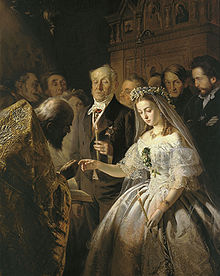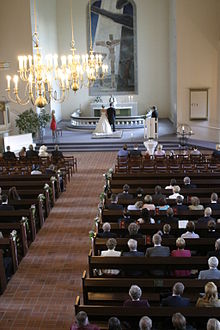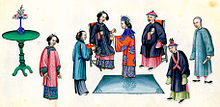- Marriage vows
-
Marriage vows are promises each partner in a couple makes to the other during a wedding ceremony. Marriage customs have developed over history and keep changing as human society develops.
Contents
Background
In secular ceremonies, vows can be chosen freely or created by the couple. Couples marrying within a religious tradition are often constrained to use the standard vows of that tradition's ceremony.
Writing one's own vows
In some countries it is common for couples to write their own vows. Inspirations are often taken from poems, movies, or music. Vows usually consist of what characteristics each bring out in each other, what they look forward to in life, how their lives changed once they met. Vows tend to be between two and three minutes in length and are a public expression of love.[citation needed]
Traditional Roman Catholic vows
Couples wedding in the Roman Catholic Church will essentially make the same pledge to one another. The customary text in English is:
I, ____, take you, ____, to be my (husband/wife). I promise to be true to you in good times and in bad, in sickness and in health. I will love you and honor you all the days of my life.[citation needed]
The priest will then say aloud "You have declared your consent before the Church. May the Lord in his goodness strengthen your consent and fill you both with his blessings. That God has joined, men must not divide. Amen."[1]
Marriage vows in England
The law in England authorises marriages to be legal if properly carried out and registered in the Church of England and some other religious bodies (e.g. Jews, Quakers): other men and women who wish to marry can be married by a local official authorised to do so (civil ceremony). Circumstances may result in the same partners having both ceremonies at different times though this is rare. The vows, presence of witnesses and civil registration are absolute requirements under the law.
Civil ceremonies often allow couples to choose their own marriage vows, although many civil marriage vows are adapted from the traditional vows, taken from the Book of Common Prayer, "To have and to hold from this day forward, for better for worse, for richer for poorer, in sickness and in health, to love and to cherish, till death us do part."[2]
They were first published in English in the prayer book of 1549, based on earlier Latin texts (the Sarum and York Rituals of the medieval period). An older version of the final phrase is "and to obey, until death us do depart" where "depart" means "separate". "Until death us do depart" had to be changed due to changes in the usage of "depart" in the Prayer Book of 1662. In the 1928 prayer book (not authorised) and in editions of the 1662 prayer book printed thereafter "and to obey" was retained (in the 1928 book an alternative version omitted this). The 1928 revised form of Matrimony was quite widely adopted, though the form of 1662 was also widely used, though less so after the introduction of the Alternative Service Book.
The original wedding vows, as printed in The Book of Common Prayer, are:
Groom: I,____, take thee,_____, to my lawful wedded Wife, to have and to hold from this day forward, for better for worse, for richer for poorer, in sickness and in health, to love and to cherish, till death us do part, according to God's holy ordinance; and thereto I plight thee my troth.
Bride: I,_____, take thee,_____, to my lawful wedded Husband, to have and to hold from this day forward, for better for worse, for richer for poorer, in sickness and in health, to love, cherish, and to obey, till death us do part, according to God's holy ordinance; and thereto I give thee my troth.
Then, as the groom places the ring on the bride's finger, he says the following:
With this Ring I thee wed, with my body I thee worship, and with all my worldly goods I thee endow: In the name of the Father, and of the Son, and of the Holy Ghost. Amen.
In the Alternative Service Book (1980) two versions of the vows are included: the bride and groom must select one of the versions only. Version A:
I,N, take you, N, to be my wife (or husband), to have and to hold from this day forward, for better, for worse, for richer, for poorer, in sickness and in health, to love and to cherish, till death us do part, according to God's holy law, and this is my solemn vow.
Version B is identical except for the clause "to love and to cherish" where the groom says "to love, cherish, and worship" and the bride says "to love, cherish, and obey".[3]
On September 12, 1922, the Episcopal Church voted to remove the word "obey" from the bride's section of wedding vows. Other churches of the Anglican Communion each have their own authorized prayer books which in general follow the vows described above though the details and languages used do vary.
Eastern Orthodox
 A wedding in the Russian Orthodox Church, c. 1860.
A wedding in the Russian Orthodox Church, c. 1860.
There are no vows exchanged during the Crowning (wedding ceremony) of the Orthodox Church. However, the priest asks first the groom then the bride:
- Priest: Hast thou, [Name], a good, free, and unconstrained will and a firm intention to take unto thyself to wife (husband) this woman (man), [Name], whom thou seest here before thee?
- Groom (Bride): I have, reverend Father.
- Priest: Thou hast not promised thyself to any other bride (man)?
- Groom (Bride): I have not promised myself, reverend Father.
It should be noted that in the Byzantine Rite, the rings are not exchanged during the wedding ceremony itself, but rather at the Betrothal. In current practice, however, the Betrothal is usually celebrated immediately before the Crowning.
References
- ^ "Catechismo della Chiesa Cattolica; pt. 2, sez. 2, cap. 3, art. 7: Il sacramento del matrimonio" (in Italian). http://www.vatican.va/archive/catechism_it/p2s2c3a7_it.htm. Retrieved 2011-04-09.
- ^ [1]: Solemnization of Matrimony, Book of Common Prayer
- ^ The Alternative Service Book 1980, together with the Liturgical Psalter. Colchester: William Clowes, 1980; pp. 290-91
Further reading
- Daniel, Evan (1948) The Prayer-Book; its history, language and contents; 26th ed. Redhill: Wells Gardner; pp. 491–96: The form of solemnization of matrimony
- Diane Warner (2006), Diane Warner's Complete Book of Wedding Vows: Hundreds of Ways to Say "I Do", Career Press, ISBN 9781564148162, http://books.google.com/?id=hdnNZ3U6iG8C&pg=PA8&dq=%22seven+steps%22
- Michael Macfarlane (1999), Wedding Vows: Finding the Perfect Words, Sterling Publishing Company, ISBN 9780806906393, http://books.google.com/books?id=W987VY-4h3IC&pg=PA89
Wikimedia Foundation. 2010.


